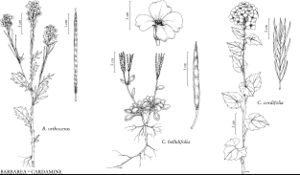Barbarea
in W. Aiton and W. T. Aiton, Hortus Kew. 4: 109. 1812.
| Taxon | Illustrator ⠉ | |
|---|---|---|
 | Barbarea orthoceras Cardamine bellidifolia Cardamine cordifolia | Yevonn Wilson-Ramsey Yevonn Wilson-Ramsey Yevonn Wilson-Ramsey |
Biennials or perennials [annuals]; (rhizomatous or with woody caudex); not scapose; glabrous or sparsely pubescent. Stems erect [prostrate], branched distally, (angular [not angular]). Leaves basal and cauline; petiolate and sessile; basal rosulate or not, (and proximal cauline) petiolate, blade margins usually entire, crenate or lobed, rarely dentate or repand; cauline sessile, blade (base auriculate or amplexicaul) margins entire, dentate, or lobed. Racemes (corymbose, several-flowered), considerably [slightly] elongated in fruit, (rachis striate). Fruiting pedicels (sometimes absent), erect to divaricate, slender or stout. Flowers: sepals (sometimes persistent), erect [spreading], oblong [ovate, linear], lateral pair saccate or not basally, (apex often cucullate); petals yellow or pale-yellow [creamy white], spatulate or oblanceolate, (longer than sepals), claw obscurely differentiated from blade, (apex obtuse or rounded); stamens tetradynamous; filaments (yellow), not dilated basally; anthers oblong, (apex obtuse); nectar glands (4): lateral annular, median toothlike. Fruits siliques, sessile or shortly stipitate, usually linear, rarely elliptic-linear, smooth or torulose, terete, 4-angled, or latiseptate; valves each with prominent midvein and distinct marginal veins, usually glabrous, rarely pubescent; replum rounded; septum complete; ovules 16–52 per ovary; style obsolete or distinct; stigma capitate, (sometimes slightly 2-lobed). Seeds uniseriate [sub-biseriate], plump or slightly flattened, not winged [winged or margined], oblong, ovoid, or orbicular; seed-coat (reticulate or, rarely, tuberculate), not mucilaginous when wetted; cotyledons accumbent. x = 8.
Distribution
North America, Europe, Asia, n Africa, Australia
Discussion
Species 22 (4 in the flora).
Barbarea is a difficult genus much in need of systematic and phylogenetic studies throughout its range. Although some of its species are easily recognizable, some complexes, especially the widespread or weedy taxa, remain problematic. It is likely that hybridization is involved, but no studies have confirmed that.
The determination of flowering material is not always possible, and most workers have relied heavily on the distalmost leaves to separate species. Both Barbarea orthoceras and B. verna are said to have pinnatisect to pinnatifid distalmost leaves, whereas B. stricta and B. vulgaris are said to have undivided, entire, or dentate leaves. This separation can be misleading because B. orthoceras sometimes has entire or dentate distal leaves, whereas in some B. vulgaris the distal leaves are deeply divided. In B. vulgaris, the style length and its thickness in relation to the fruits are useful in separating it from the remaining species, though, on rare occasions, both B. orthoceras and B. stricta have slender styles to 2 mm. In these cases, both B. orthoceras and B. stricta can be separated from B. vulgaris by the ciliate auricles of cauline leaves and subapically pubescent sepals. Both sepals and auricles of distalmost leaves are always glabrous in B. vulgaris. Although all the Eurasian specimens of B. stricta that I examined have pubescent auricles and sepal apices, the number of trichomes can be quite variable and ranges from one to many. Most of the naturalized North American plants of B. stricta have glabrescent or glabrous sepals. However, that species can be further distinguished by having petals 2.5–4.5 × 0.5–1(–1.2) mm, the smallest and narrowest among the four species growing in North America. In the absence of mature fruits, one needs to be aware of the variation in the other characters.
Selected References
Lower Taxa
Key
| 1 | Fruits (4.5-)5.3-7(-8) cm; ovules (34-)38-48(-52) per ovary; fruiting pedicels as broad as fruit; cauline leaf blades pinnatifid to pinnatisect. | Barbarea verna |
| 1 | Fruits (0.7-)1.5-4(-4.5) cm; ovules 16-36 per ovary; fruiting pedicels narrower than fruit; cauline leaf blades undivided or lyrate-pinnatifid | > 2 |
| 2 | Styles (1-)1.5-3(-3.5) mm, slender; auricles of cauline leaves glabrous; fruits usually not appressed to rachises. | Barbarea vulgaris |
| 2 | Styles 0.2-1.5(-2) mm, sometimes stout; auricles of cauline leaves usually sparsely pubescent, rarely glabrous, sometimes margins ciliate; fruits (erect to erect-ascending) sometimes appressed to rachises | > 3 |
| 3 | Fruits (1.2-)1.8-2.8(-3) cm; ovules (16-)20-28 per ovary; petals 2.5-4.5 × 0.5-1 (-1.2) mm; cauline leaf blade margins dentate. | Barbarea stricta |
| 3 | Fruits (2.5-)3.1-4(-4.5) cm; ovules (24-)26-36 per ovary; petals 5-7(-8) × (1.5-)2-3 mm; cauline leaf blade margins incised or pinnatifid. | Barbarea orthoceras |
"elongated" is not a number."thick" is not a number.